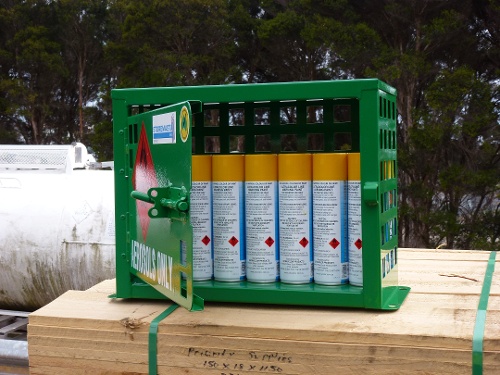As Class 2 dangerous goods, aerosol cans have been responsible for countless workplace accidents in Australia, as well as other parts of the world. Often, these little cans are not treated with the care that they deserve, with supervisors and their staff unaware that the aerosols can easily ignite and explode. In this post, we highlight the ways in which aerosols have contributed to workplace accidents — and how they can be stored safely. We’ll also detail why having a dedicated aerosol storage cage is essential for minimising the many hazards associated with these dangerous goods.
Why Dedicated Aerosol Storage is Important
Aerosol cans have the potential to cause major workplace accidents. This is due to the hazards associated with the substance within the aerosol can, as well as the metal canister that the substance is stored within.
Some common aerosol can hazards may include:
- The flammability of the stored substance
- The metal canister becoming a projectile
- The volatility of the aerosol can when it’s exposed to sources of heat
Therefore, to reduce the serious hazards associated with Class 2 aerosols in the workplace, dedicated storage is required.
Dedicated aerosol storage is essential for minimising the risks associated with these commonly-found dangerous goods.
Some key considerations for storing aerosol cans include the separation from sources of ignition and heat, projectile protection within the aerosol store, segregation from incompatible substances and separation from public places. It’s also important to provide protection for the cans during storage so that impact damage, theft or misuse is controlled.
IMPORTANT: Like to learn more about the safe storage of aerosol cans in the workplace? Check out our blog, Storing Aerosols Correctly for more information.
Aerosol Hazards in the Workplace
We’ll now take a look at 3 workplaces incidents involving aerosol cans, so we can understand how these accidents can occur – and what we can do to prevent the likelihood and impact of an aerosol incident occurring in the future.
1. Dispensed Substances Can Be Highly Flammable
A worker was using an adhesive spray glue near a gas hot water system (despite being warned not to use the glue near an open flame). He accidentally dropped the can of adhesive and it landed near the burning pilot light. When he went to pick up the can, he somehow depressed the spray button and ignited the glue. He suffered 2nd degree burns and was hospitalised.
Aerosol cans use propellants and solvents to dispense the active ingredient from the can (that’s the stuff you are using eg paint, WD40, glue) and maintain an even consistency. Hydrocarbons (propellants), methylal and dioxolane (aerosol solvents) are highly flammable and in many cases the active ingredient is flammable as well. Because of this aerosol cans are easily ignited when they are being used.
IMPORTANT: It is a requirement of AS/NZS 3833 - The storage and handling of mixed classes of dangerous goods, in packages and intermediate bulk containers that aerosols must be kept at least 3 metres from heat and ignition sources.
2. Metal Canisters Can Become Dangerous Projectiles
A worker was holding a can of spray paint as he walked through an industrial workshop. For some reason, the aerosol can exploded and struck him in the chest. He died from internal injuries.
Aerosol cans are a self-contained dispensing system that store and discharge substances under pressure, the whole system is made up of various different components that can become volatile if not handled or stored correctly.

The potential for an aerosol can to become a projectile is a key concern when carrying any quantity of aerosol in the workplace.
These include the:
- Metal canister itself
- Flammable propellant and solvents
- Active ingredient (often flammable, corrosive and toxic);
- And the componentry of the metal valve (gaskets, metal spring, dip tube) valve cup and seat)
Workplace accidents where aerosol cans have unexpectedly launched into dangerous missiles have been documented in the USA and Australia. In these accidents, workers received lacerations, broken bones, and facial injuries (eg, detached retinas and damaged tear ducts). In some of these accidents (like the one above) the workers have died.
IMPORTANT: Aerosol cans should be handled and stored according the manufacturer’s instructions used before the expiry date. Always check the Safety Data Sheet (SDS) that accompanies the spray cans for handling and storage essentials.
3. Cans Explode When Exposed To Heat
Exposing aerosol canisters to heat is probably the most common cause of workplace accidents involving aerosols.
These 3 examples show how quickly an aerosol can turn into a hazard when exposed to heat:
- Can of cooking oil left on the hot plate at a busy commercial kitchen explodes, burns two chefs, and blows out the front window of the cafe.
- Can of paint left in the sun is shaken for use and explodes in the hand of the worker.
- Can of adhesive spray left near a heat gun and explodes, an interior designer is burned and her workshop badly damaged.
Aerosol cans store substances under pressure. When the cans become hot, the pressurised gas inside the can begins to expand.
The pressurised can will eventually explode; the componentry scattered at high pressure as shrapnel; and the active ingredient, propellant and solvent likely to ignite. Imagine if this happened in your dangerous goods store.
IMPORTANT: It is a requirement of AS/NZS 3833 - The storage and handling of mixed classes of dangerous goods, in packages and intermediate bulk containers that aerosol cans must be protected from the weather and direct sunlight.
What is an Aerosol Storage Cage?
The recommended solution for aerosols in the workplace is the installation of an aerosol storage cage. These aerosol storage solutions are designed and constructed to control the many risks associated with aerosol cans.
A dedicated aerosol cage is manufactured according to the strict guidelines of AS 4332 - The storage and handling of gases in cylinders.
%20(1).jpg?width=500&height=375&name=IMG_3475%20(1)%20(1).jpg)
Aerosol cages are a safe and compliant method for storing your aerosols.
Features of compliant aerosol storage cages include:
- Ventilation: Aerosol cages have perforated walls which provide natural ventilation. If a canister should leak the contents will dissipate naturally and won’t accumulate or cause pressure built up in the cabinet.
- Projectile Protection: Aerosol cages feature heavy duty steel construction and offer projectile projection if one (or all) of the cans happened to explode. The explosion would be contained within the cabinet.
- Weather Protection: Aerosol cages keep the cans undercover and protected from the weather and sunlight. Weather exposure can cause corrosion which may interfere with the valve and button componentry, while direct sunlight can deteriorate the can or cause it to overheat and explode.
- Security: Aerosol cages have sturdy bolt locks which can be padlocked so that unauthorised personnel cannot gain access to the aerosol cans. This is particularly important for aerosol spray paints.
- Shelving: The heavy-duty shelving in aerosol cages is ideal for aerosol storage. The cans may be stored singularly or in bulk (kept inside their original cartons). It is a requirement of Australian Standards that cans are stored in a manner that reduces the risk of collapse of stacks or any damage to the aerosol containers.
NOTE: Aerosol storage cages Storemasta arrive complete with mandatory placards and safety signage.
Where to Install an Aerosol Storage Cage
Whether you’re considering the storage of aerosols in a warehouse or how to keep your aerosols in your manufacturing facility, the placement of your aerosol storage cage is a key consideration.
Due to the volatile nature of aerosol cans, these cages should always be kept in an outdoor location. This is to reduce the likelihood of human harm caused by the accidental release of the chemical substance, as well as protect people and property from the can if they become projectiles.
In addition to this, you must ensure that your aerosol storage cabinet is installed away from heat and ignition sources such as direct sunlight, hot work, flames, industrial heat and static electricity. Aerosol cages must be kept in a protection outdoor position, that is not vulnerable to extreme weather conditions. Consider a position that will be protected from flying debris (such as falling branches, corrugated iron sheeting or rubbish) in the event of a violent storm.
It’s not recommended to keep aerosol storage cages in a busy, indoor environment such as warehouses, production lines, mechanical workshops and hospitality premises. The indoor storage of aerosols only increases the risks associated with these dangerous goods, including the possibility of ignition, incompatibility hazards and impact damage.
REMEMBER: You must separate your Class 2 aerosols from all incompatible dangerous goods.
Safer Storage with Aerosol Storage Cages
Thanks for reading our post on the importance of installing a dedicated storage solution for your aerosol cans. To prevent incidences involving aerosols — such as the 3 accidents that we’ve highlighted today, from occurring in your own workplace — you should consider the installation of compliant aerosol cages.
If you’re a WHS Manager or Supervisor who is responsible for managing the dangerous goods in your workplace, we have a FREE eBook that can help you stay safe and compliant. Aerosol Safety and Storage is an excellent resource for anyone wanting to know how to properly store aerosols and other compressed gases.
Joining the team as a Dangerous Goods Storage Consultant, Melissa Hampton became Storemasta's Marketing Manager in late 2021. With extensive knowledge and experience in chemical compliance, Melissa is responsible for leading the Marketing team and helping shape their marketing strategy. In her spare time, you can find Melissa hiking, swimming and enjoying the great outdoors in beautiful north-west Tasmania.

